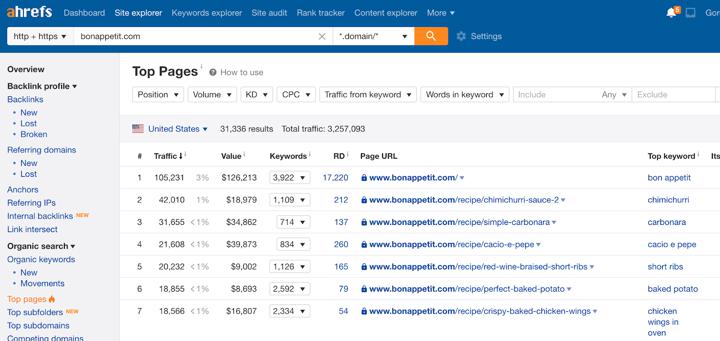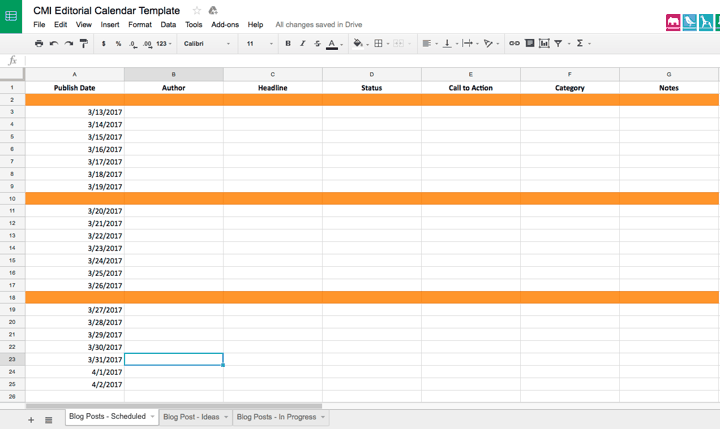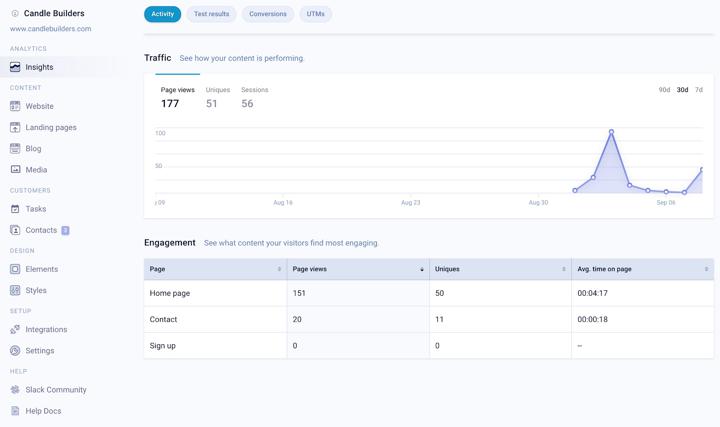If I had a dollar for every time I’ve googled “content strategy,” I wouldn't be here sitting at my desk typing this right now. But I also wouldn’t be here if I hadn’t kept on searching and trying out new systems to see what worked to create a solid strategy that performs.

So, to let you skip the searching and get right to growing your business, I’m going to share how to build, measure, and scale your content strategy. I’ll break these three stages into seven simple steps:
- Do your keyword and competitive research
- Create a calendar
- Publish more content
- Set up automated reports
- Review progress and optimize as needed
- Repurpose high-performing content
- Repeat, repeat, repeat
Ready? Let’s jump in.
Build
Getting started is always the hardest part, isn’t it? To build out a content strategy, you need to do your research, organize a plan, and—of course—get writing. But spending extra time here to build a solid foundation will help you when you get to measuring and scaling later on. Trust me.
1. Do your research—keyword and competitive
To write a blog post, you need to know two things: your audience and your topic. (Let me be clear: To write an awesome blog post that any editor would be stoked to review or a high-traffic blog post marketing managers dream of, you need to know a lot more, but these are the basics.)
You need to start with your audience and your topic for your overall content strategy, too. Your target personas—or ideal customers—are your audience. Research will help you determine what topics to cover, and you need to spend time looking at your competitor’s content. What terms do these companies rank for? How many backlinks do their top pages have?

It’s not surprising that Bon Appetit’s top pages include a carbonara recipe. It’s also not a bad idea for dinner. (Pro tip: Make it with egg yolks or don’t make it at all.)
Then, with that context, start looking for keyword opportunities.
I’d start by searching broad topics in your keyword tool of choice (like Ahefs or Semrush), and then look at lists like “Also rank for” and “All keyword ideas” with high-traffic, low-difficulty keywords.
2. Create a comprehensive content calendar
I used to think organization was my least impressive skill. It sounds like the compliment you give a boring girl in sixth grade who would always lend you her pencil because she always had extras. (Looking at you, Bobby Delaney.)
But keeping everything in place is so much more than extra pencils and color-coordinated sticky notes. It’s also crucial in building a successful content marketing strategy.
With so many moving pieces—blog posts, video scripts, product announcements—you need to make sure you have all the important information in one central location, like a spreadsheet or a project management tool. As for information, keyword, keyword volume, author, CTAs, and publication date are good to start with.

The Content Marketing Institute has a good template to get started.
And if you keep double checking on other info for your business—a blog category or author type, maybe—then go ahead and add that, too.
3. Publish more content
With your audience considered, your keywords defined, and your calendar created, you have a solid foundation. You need the content next, which makes this a boring step, but a really important one. Keep banging out that high-quality content and keep publishing it.
How often depends largely on your resources, because quality is more important here. But, according to recent research from HubSpot, you’ll see the best results for organic traffic and brand awareness if you publish new blog posts at least 2-3 times per week.
Looking to add some interactive content? Check out these expert-approved examples.
Measure
Even exceptional content won’t help you grow your business if no one’s reading it. To have an effective content marketing strategy, you need to make sure you’re regularly measuring the results. Here’s how to get started.
4. Set up your reporting
The biggest measurement for a content strategy is usually traffic, but you’ll also want to consider other metrics, like dwell time and conversion rates to make sure that you’re driving the right audience to your website and into your marketing funnel.
Once you’ve identified your key metrics, set up an automated report in Google Analytics so that you can see all these at a glance to easily identify any changes.
If you’re using Unstack, you can take it easy here: This dashboard is set up automatically and available right in your account under “Analytics.”

For more details on setting up and using reporting, check out our guide to content analytics.
5. Review progress and optimize as needed
Remember when you spent time creating a content calendar with all those details like keyword volumes, author names, channels, and more? You did that to help yourself with this step.
Take a look at your content calendar and dashboard simultaneously. Are you ranking for targeted keywords? Are you ranking for any additional keywords you can work into your blog posts? How’s your intent match? Does one blog author outperform the others?
Consider the performance so that you can find patterns—that way, you can work to replicate those successes, which brings us to the last stage.
Scale
You've built out your marketing plan, and you're regularly measuring and optimizing for performance. The next step: scaling.
Here are two steps for using your content marketing as a tool to grow your business.
6. Repurpose high-performing content
In most areas of my life, I’m not thrifty.
My grandmother used to make my sisters and I matching dresses as kids; one of my best friends takes old furniture or discarded wood and creates cute new chairs or beachy picture frames. I do my best to replace buttons, and I feel like a pioneer woman every time I clean out a glass jam jar and reuse it for cashews or paper clips.
Content, however, is another story. I believe great content should reach as many people as possible—and often the best way to do that is to repurpose your content. A blog post is a great starting point for a webinar or a YouTube video script. A video and its bloopers can be spliced for social clips.

A great example of repurposing in action, our YouTube video also appears on our blog with a skimmable, searchable transcript.
To scale your content marketing strategy, you need to think strategically about repurposing your high-performing content to get even more out of it.
Not sure which content channels to focus on? Check the top content marketing trends for 2020!
7. Repeat, repeat, repeat
Getting to this step is like finally reaching the top of the mountain: It’s so beautiful and serene that you’re almost okay with having to do the hike all over again to get home.
The key to scaling a content strategy is continuing to build and measure and scale again. Your audience might change slightly. Your industry will have new trends and topics. Google’s algorithms will almost certainly force your SEO strategy to shift over time.
The good news? You deserve to take a minute to enjoy the fruits of your labor—all those sessions and conversions and video views are great for your growing business.
